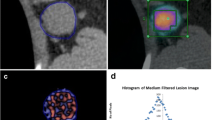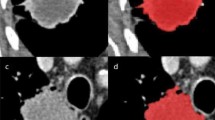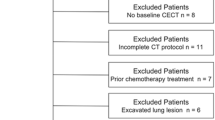Abstract
Purpose
To determine whether texture analysis features on pretreatment contrast-enhanced computed tomography (CT) images can predict overall survival (OS) and progression-free survival (PFS) in patients with metastatic malignant melanoma (MM) treated with an anti-PD-1 monoclonal antibody, pembrolizumab.
Materials and methods
This institutional-approved retrospective study included 31 patients with metastatic MM treated with pembrolizumab. Texture analysis of 74 metastatic lesions was performed on CT scanners obtained within 1 month before treatment. Mean gray-level, entropy, kurtosis, skewness, and standard deviation values were derived from the pixel distribution histogram before and after spatial filtration at different anatomic scales, ranging from fine to coarse. Lasso penalized Cox regression analyses were performed to identify independent predictors of OS and PFS.
Results
Median OS and PFS were 357 days (range 42–1355) and 99 days (range 35–1185), respectively. Skewness at coarse texture scale (SSF = 6; HR (CI 95%) = 6.017 (1.39, 26.056), p = 0.016), Response evaluation criteria in solid tumors (RECIST) conclusion (HR (CI 95%) = 3.41 (1.17, 9.89), p = 0.024), and body weight (HR (CI 95%) = 0.96 (0.92, 0.995), p = 0.026) were independent predictors of OS. Skewness at coarse texture scale (SSF = 6; HR (CI 95%) = 4.55 (1.46, 14.13), p = 0.0089) and RECIST conclusion (HR (CI 95%) = 10.63 (3.11, 36.29), p = 0.00016) were independent predictors of PFS. Skewness values above − 0.55 at coarse texture scale were significantly associated with both lower OS and lower PFS after administration of pembrolizumab.
Conclusion
Pretreatment CT texture analysis–derived tumor skewness may act as predictive biomarker of OS and PFS in patients with metastatic MM treated with pembrolizumab.
Key Points
• Pretreatment skewness at coarse texture scale in metastases from malignant melanoma was an independent predictor of overall survival and progression-free survival.
• Skewness values above −0.55 at coarse texture scale were significantly associated with both lower OS and lower PFS after administration of pembrolizumab.
• In patients with metastatic MM, texture analysis performed on pretreatment CT may act as a useful tool to select the best candidates for pembrolizumab therapy.




Similar content being viewed by others
Abbreviations
- CT:
-
Computed tomography
- ECOG:
-
Eastern cooperative oncology group
- HR:
-
Hazard ratio
- LDH:
-
Serum lactate dehydrogenase
- MM:
-
Malignant melanoma
- OS:
-
Overall survival
- PD-1:
-
Program cell death 1
- PFS:
-
Progression-free survival
- RECIST:
-
Response evaluation criteria in solid tumors
- ROI:
-
Region of interest
- SD:
-
Standard deviation
- SSF:
-
Spatial scale image filtration
References
Ferlay J, Soerjomataram I, Dikshit R et al (2015) Cancer incidence and mortality worldwide: sources, methods and major patterns in GLOBOCAN 2012: Globocan 2012. Int J Cancer 136:E359–E386
Lens MB, Dawes M (2004) Global perspectives of contemporary epidemiological trends of cutaneous malignant melanoma. Br J Dermatol 150:179–185
Sandru A, Voinea S, Panaitescu E, Blidaru A (2014) Survival rates of patients with metastatic malignant melanoma. J Med Life 7:572–576
Robert C, Karaszewska B, Schachter J et al (2015) Improved overall survival in melanoma with combined dabrafenib and trametinib. N Engl J Med 372:30–39
Larkin J, Ascierto PA, Dréno B et al (2014) Combined vemurafenib and cobimetinib in BRAF-mutated melanoma. N Engl J Med 371:1867–1876
Robert C, Long GV, Brady B et al (2015) Nivolumab in previously untreated melanoma without BRAF mutation. N Engl J Med 372:320–330
Robert C, Schachter J, Long GV et al (2015) Pembrolizumab versus ipilimumab in advanced melanoma. N Engl J Med 372:2521–2532
Wolchok JD, Chiarion-Sileni V, Gonzalez R et al (2017) Overall survival with combined nivolumab and ipilimumab in advanced melanoma. N Engl J Med 377:1345–1135
Diem S, Kasenda B, Spain L et al (2016) Serum lactate dehydrogenase as an early marker for outcome in patients treated with anti-PD-1 therapy in metastatic melanoma. Br J Cancer 114:256–261
Tsai KK, Loo K, Khurana N et al (2015) Clinical characteristics predictive of response to pembrolizumab in advanced melanoma. J Clin Oncol 33:9031–9031
Nosrati A, Tsai KK, Goldinger SM et al (2017) Evaluation of clinicopathological factors in PD-1 response: derivation and validation of a prediction scale for response to PD-1 monotherapy. Br J Cancer 116:1141–1147
Martin-Liberal J, Kordbacheh T, Larkin J (2015) Safety of pembrolizumab for the treatment of melanoma. Expert Opin Drug Saf 14:957–964
Eisenhauer EA, Therasse P, Bogaerts J et al (2009) New response evaluation criteria in solid tumours: revised RECIST guideline (version 1.1). Eur J Cancer 45:228–247
Rao SX, Lambregts DM, Schnerr RS et al (2016) CT texture analysis in colorectal liver metastases: a better way than size and volume measurements to assess response to chemotherapy? United European Gastroenterol J 4:257–263
Ganeshan B, Miles KA (2013) Quantifying tumour heterogeneity with CT. Cancer Imaging 13:140–149
Lubner MG, Smith AD, Sandrasegaran K, Sahani DV, Pickhardt PJ (2017) CT texture analysis: definitions, applications, biologic correlates, and challenges. Radiographics 37:1483–1503
Ng F, Ganeshan B, Kozarski R, Miles KA, Goh V (2013) Assessment of primary colorectal cancer heterogeneity by using whole-tumor texture analysis: contrast-enhanced CT texture as a biomarker of 5-year survival. Radiology 266:177–184
Ganeshan B, Skogen K, Pressney I, Coutroubis D, Miles K (2012) Tumour heterogeneity in oesophageal cancer assessed by CT texture analysis: preliminary evidence of an association with tumour metabolism, stage, and survival. Clin Radiol 67:157–164
Yip C, Landau D, Kozarski R et al (2014) Primary esophageal cancer: heterogeneity as potential prognostic biomarker in patients treated with definitive chemotherapy and radiation therapy. Radiology 270:141–148
Zhang H, Graham CM, Elci O et al (2013) Locally advanced squamous cell carcinoma of the head and neck: CT texture and histogram analysis allow independent prediction of overall survival in patients treated with induction chemotherapy. Radiology 269:801–809
Ganeshan B, Panayiotou E, Burnand K, Dizdarevic S, Miles K (2012) Tumour heterogeneity in non-small cell lung carcinoma assessed by CT texture analysis: a potential marker of survival. Eur Radiol 22:796–802
Miles KA (2016) How to use CT texture analysis for prognostication of non-small cell lung cancer. Cancer Imaging 16:10
Ganeshan B, Miles KA, Babikir S et al (2017) CT-based texture analysis potentially provides prognostic information complementary to interim FDG-PET for patients with Hodgkin’s and aggressive non-Hodgkin’s lymphomas. Eur Radiol 27:1012–1020
Mulé S, Thiefin G, Costentin C et al (2018) Advanced hepatocellular carcinoma: pretreatment contrast-enhanced CT texture parameters as predictive biomarkers of survival in patients treated with sorafenib. Radiology:171320
Ravanelli M, Farina D, Morassi M et al (2013) Texture analysis of advanced non-small cell lung cancer (NSCLC) on contrast-enhanced computed tomography: prediction of the response to the first-line chemotherapy. Eur Radiol 23:3450–3455
Tian F, Hayano K, Kambadakone AR, Sahani DV (2015) Response assessment to neoadjuvant therapy in soft tissue sarcomas: using CT texture analysis in comparison to tumor size, density, and perfusion. Abdom Imaging 40:1705–1712
Yip C, Davnall F, Kozarski R et al (2015) Assessment of changes in tumor heterogeneity following neoadjuvant chemotherapy in primary esophageal cancer. Dis Esophagus 28:172–179
Ahn SJ, Kim JH, Park SJ, Han JK (2016) Prediction of the therapeutic response after FOLFOX and FOLFIRI treatment for patients with liver metastasis from colorectal cancer using computerized CT texture analysis. Eur J Radiol 85:1867–1874
Smith AD, Gray MR, del Campo SM et al (2015) Predicting overall survival in patients with metastatic melanoma on antiangiogenic therapy and RECIST stable disease on initial posttherapy images using CT texture analysis. AJR Am J Roentgenol 205:W283–W293
Nishino M, Jagannathan JP, Ramaiya NH, Van den Abbeele AD (2010) Revised RECIST guideline version 1.1: what oncologists want to know and what radiologists need to know. AJR Am J Roentgenol 195:281–289
Simon N, Friedman J, Hastie T, Tibshirani R (2011) Regularization paths for Cox’s proportional hazards model via coordinate descent. J Stat Softw 39:1–13
Shrout PE, Fleiss JL (1979) Intraclass correlations: uses in assessing rater reliability. Psychol Bull 86:420–428
Yun Z, Lin Q (2014) Hypoxia and regulation of cancer cell stemness. Adv Exp Med Biol 772:41–53
Ganeshan B, Goh V, Mandeville HC, Ng QS, Hoskin PJ, Miles KA (2013) Non-small cell lung cancer: histopathologic correlates for texture parameters at CT. Radiology 266:326–336
Hayano K, Tian F, Kambadakone AR et al (2015) Texture analysis of non-contrast-enhanced computed tomography for assessing angiogenesis and survival of soft tissue sarcoma. J Comput Assist Tomogr 39:607–612
Dummer R, Hauschild A, Guggenheim M, Keilholz U, Pentheroudakis G, ESMO Guidelines Working Group (2012) Cutaneous melanoma: ESMO clinical practice guidelines for diagnosis, treatment and follow-up. Ann Oncol 23(Suppl 7):vii86–vii91
Hodi FS, Hwu WJ, Kefford R et al (2016) Evaluation of immune-related response criteria and RECIST v1.1 in patients with advanced melanoma treated with pembrolizumab. J Clin Oncol 34:1510–1517
Ahn SY, Park CM, Park SJ et al (2015) Prognostic value of computed tomography texture features in non-small cell lung cancers treated with definitive concomitant chemoradiotherapy. Investig Radiol 50:719–725
Miles KA, Ganeshan B, Hayball MP (2013) CT texture analysis using the filtration-histogram method: what do the measurements mean? Cancer Imaging Soc 13:400–406
Ng F, Kozarski R, Ganeshan B, Goh V (2013) Assessment of tumor heterogeneity by CT texture analysis: can the largest cross-sectional area be used as an alternative to whole tumor analysis? Eur J Radiol 82:342–348
Marusyk A, Almendro V, Polyak K (2012) Intra-tumour heterogeneity: a looking glass for cancer? Nat Rev Cancer 12:323–334
Miles KA, Ganeshan B, Griffiths MR, Young RC, Chatwin CR (2009) Colorectal cancer: texture analysis of portal phase hepatic CT images as a potential marker of survival. Radiology 250:444–452
Funding
The authors state that this work has not received any funding.
Author information
Authors and Affiliations
Corresponding author
Ethics declarations
Guarantor
The scientific guarantor of this publication is Carole Durot, MD, Centre Hospitalo-universitaire de Reims.
Conflict of interest
The authors of this manuscript declare no relationships with any companies whose products or services may be related to the subject matter of the article.
Statistics and biometry
One of the authors has significant statistical expertise.
Informed consent
Written informed consent was obtained from all subjects (patients) in this study.
Ethical approval
Institutional Review Board approval was obtained.
Methodology
• retrospective
• diagnostic or prognostic study
• performed at one institution
Additional information
Publisher’s Note
Springer Nature remains neutral with regard to jurisdictional claims in published maps and institutional affiliations.
Rights and permissions
About this article
Cite this article
Durot, C., Mulé, S., Soyer, P. et al. Metastatic melanoma: pretreatment contrast-enhanced CT texture parameters as predictive biomarkers of survival in patients treated with pembrolizumab. Eur Radiol 29, 3183–3191 (2019). https://doi.org/10.1007/s00330-018-5933-x
Received:
Revised:
Accepted:
Published:
Issue Date:
DOI: https://doi.org/10.1007/s00330-018-5933-x




